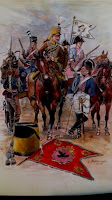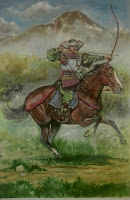 |
| Trzyglaw by Marek Hapon (Wiki Commons) |
Salvete Omnes,
coming this April the American (and Australian and New Zealand as well) book stores will see the newest edition of the famous 'Viking and Slavic Ornamental Design' volume 1, by Igor Gorewicz et al, originally published by Wydawnictwo Triglav from Szczecin, Poland.
It was the ancient stronghold of Szczecin on the banks of Odra (Oder ) River in western Pomerania on the southern Baltic shores, where a thousand years ago stood many pagan temples and where among other deities the pagan Wkrzanie (Ukrani - a western Slavic tribe) worshiped Slavic god known as Trzyglaw (Triglav). The island of Wolin was the site of the famous viking-Slavic stronghold Jomsborg (Jomsviking saga), and on the island of Rugia or Rana ( Rugen) stood famous temple of Slavic god Swiatowid (Svetovid) where a 'holy' white stallion was used in the horse oracle ceremeony by the Slavic priests well into the second half of the XII century (until the Danish conquest and destruction of the Svetovid temple on the Cape Arkona in 1168AD)
 |
| Deities of Ranowie or Rugianie (Rani - western Slavic tribe) by Marek Hapon |
 |
| Swiatowid by Marek Hapon |
 |
| Alfons Mucha, Swiatowid worship on Rugia |
 |
| Mucha's apotheosis of the Slavs |
The books represent the combined 'transatlantic' effort of Winged Hussar Publishing LLC and Wydawnictwo Triglav.
Consecutive months of 2019 will see release of volume 2 and subsequently volume 3 of this great series.
sample pages of the volume



valete














































